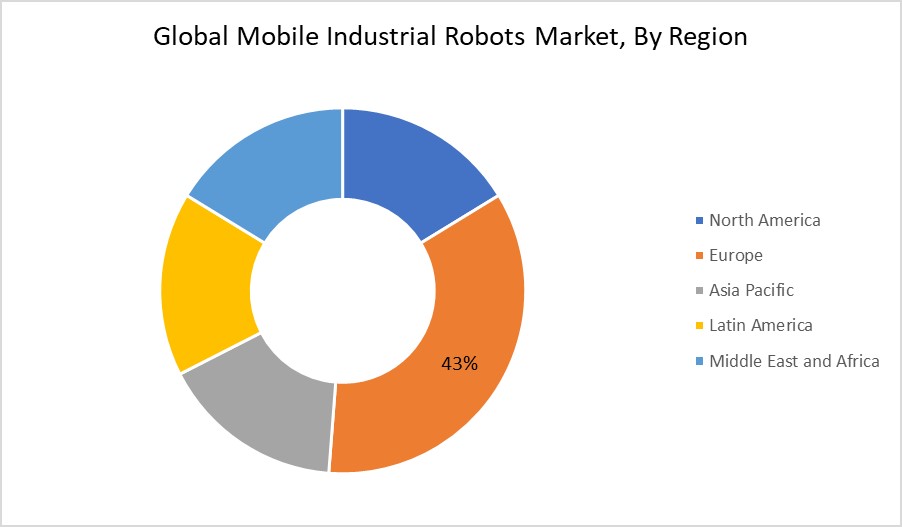Rising influx for warehouse automation, rising demand for human life safety, rising demand for mobile logistics from online retailers, rising commercialization of the idea of automated cars due to robotics technology advancements, rising adoption by the military and defense, and rising growth of mobile robots by end-users in the agricultural, medical, and other industries are all important factors accelerating the mobile industrial robots market growth. Additionally, the global geriatric population is increasing, driving up demand for service robots to aid the old, which will further open up new prospects for the market for mobile robots throughout the research above period. However, among other things, rising initial acquisition costs and difficulties working in unproven environments are the main factors that will restrain the market growth. Rising safety concerns when working with humans will also present additional difficulties for the market for mobile industrial robots during the forecast mentioned above.
COVID-19 IMPACT
COVID-19 is projected to be in effect for a few years, but its effect on the market for mobile industrial robots is uncertain. The COVID-19 breakout drove governments worldwide to enact strict lockdown measures and ban the import and export of raw materials for the majority of 2020 and a few months of 2021. As a result, the supply of crucial parts used to manufacture mobile industrial robots suddenly decreased. Additionally, the widespread lockdown compelled factories that make mobile industrial robots to partially or entirely cease operations. Globally, the COVID-19 pandemic's negative effects have caused delays in efforts and initiatives to develop mobile industrial robots.
DRIVING FACTORS
Increased Use Of Mobile Robotics In Agriculture Will Fuel Market Growth
The adoption of mobile robots in the agricultural sector is one of the key developments that is having a favorable impact on the worldwide market for mobile industrial robots. In order to increase yields and sustain productivity, farmers are implementing robotic technology. As an illustration, harvesting management is the most popular use for agricultural robots because it is essential for comprehending field variability and assists farmers in increasing yields. To automate the picking procedure, mobile industrial robots also utilize cutting-edge 3D vision systems and flexible grippers.
RESTRAINING FACTORS
Limited Market Expansion Due To High Initial Acquisition Costs
Mobile industrial robots are not as widely used as they could be because of their high installation costs and integration requirements. Because high-quality hardware is combined with a powerful software control system, the initial investment and ongoing maintenance expenses of using robotics systems are significant. Mobile industrial robot use is restricted in several sectors, including healthcare, logistics, education, agriculture, and others, due to the expensive initial investment required, limiting market expansion.
SEGMENTATION
By Product

Based on product, the mobile industrial robots market is segmented into unmanned ground vehicle (UGV), unmanned aerial vehicle (UAV), and autonomous underwater vehicle (AUV). The unmanned aerial vehicle (UAV) category dominated the market in 2022. A drone is an unmanned aerial vehicle (UAV), an aircraft without a human pilot, crew, or passengers. Unmanned aerial vehicles (UAVs) are a part of unmanned aircraft systems (UAS), which also feature the addition of a controller on the ground and a communications network with the UAV.
By Component
Based on component, the mobile industrial robots market is segmented into hardware, software, and support & service. The hardware category dominated the market in 2022. The hardware element includes controllers, wheels, brakes, motors, batteries, encoders, actuators, sensors, and power systems. These components are utilized to construct mobile industrial robots.
By Application
Based on application, the mobile industrial robots market is segmented into logistics & warehousing, military & defense, healthcare, domestic, entertainment, education, agriculture & forestry and others (personal & inspection and maintenance). The logistics & warehousing category dominated the market in 2022 due to increase e-commerce sales, forcing facility owners to increase their storage space to keep up with demand. Additionally, the cost of building warehouses and distribution centers are rising in inventory levels and labour costs, forcing warehouse operators to automate their operational workflow.
REGIONAL INSIGHTS

Europe is projected to hold the largest mobile industrial robots market share over the forecast period. This can be linked to the incumbents in the manufacturing industry's increasing demand for material handling equipment. The regional market's expansion is also fuelled by continued process automation in other business verticals and industries. On the other hand, the Asia Pacific mobile industrial robots market is anticipated to grow significantly. The expanding e-commerce sector in Asia Pacific's emerging economies encourages the use of mobile industrial robots for inventory management. Due to the fierce competition within the e-commerce sector as e-commerce businesses attempt to distinguish themselves by slashing the time it takes to deliver goods, the adoption of mobile industrial robots is also gaining momentum.
LIST OF KEY COMPANIES PROFILED:
- AMAZON ROBOTICS (AMAZON.COM)
- BOSTON DYNAMICS (SOFTBANK GROUP CORP.)
- HONDA MOTOR CO., LTD.
- IROBOT CORPORATION
- KUKA AG
- KONGSBERG MARITIME
- LOCKHEED MARTIN CORPORATION
- NORTHROP GRUMMAN CORPORATION
- SOFTBANK ROBOTICS
- UBTECH ROBOTICS, INC
- August 2020: A new mobile robot was introduced by Sesto Robotics that is intended to automate material handling procedures in the manufacturing, retail, and healthcare sectors.
REPORT SCOPE AND SEGMENTATION
| Attributes | Details |
| Study Period | 2016-2030 |
| Base Year | 2022 |
| Estimated Year | 2023 |
| Forecast Period | 2023-2030 |
| Historical Period | 2016-2021 |
| Unit | Revenue (USD Million) and Volume (Kilo Tons) |
| Segmentation | By Product, By Component, By Application and By Geography |
| By Product |
|
| By Component |
|
| By Application |
|
| By Region |
|



